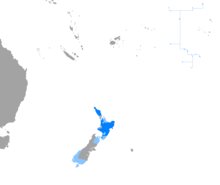Māori speakers
| Māori | |
|---|---|
| Te Reo | |
| Native to | New Zealand |
| Region | Polynesia |
| Ethnicity | Māori people |
|
Native speakers
|
60,000 (2009) 150,000 conversant (2013 census) |
|
Latin (Māori alphabet) Māori Braille |
|
| Official status | |
|
Official language in
|
|
| Regulated by | Māori Language Commission |
| Language codes | |
| ISO 639-1 | mi |
| ISO 639-2 |
mao (B)mri (T)
|
| ISO 639-3 | |
| Glottolog | maor1246 |
| Linguasphere | 39-CAQ-a |
 |
|
Māori (/ˈmaʊəri/; Māori pronunciation: [ˈmaːɔɾi] ![]() listen), also known as Te Reo ("the language"), is an Eastern Polynesian language spoken by the Māori people, the indigenous population of New Zealand. Since 1987, it has been one of New Zealand's official languages. It is closely related to Cook Islands Māori, Tuamotuan, and Tahitian.
listen), also known as Te Reo ("the language"), is an Eastern Polynesian language spoken by the Māori people, the indigenous population of New Zealand. Since 1987, it has been one of New Zealand's official languages. It is closely related to Cook Islands Māori, Tuamotuan, and Tahitian.
According to a 2001 survey on the health of the Māori language, the number of very fluent adult speakers was about 9% of the Māori population, or 30,000 adults. A national census undertaken in 2006 says that about 4% of the New Zealand population, or 23.7% of the Māori population, could hold a conversation in Māori about everyday things.
There was originally no native writing system for Māori. Missionaries brought the Latin alphabet around 1814, and linguist Samuel Lee worked with chief Hongi Hika to systematize the written language in 1820. The resultant phonetic spellings were remarkably successful. Written Māori has changed little since then.
...
Wikipedia
